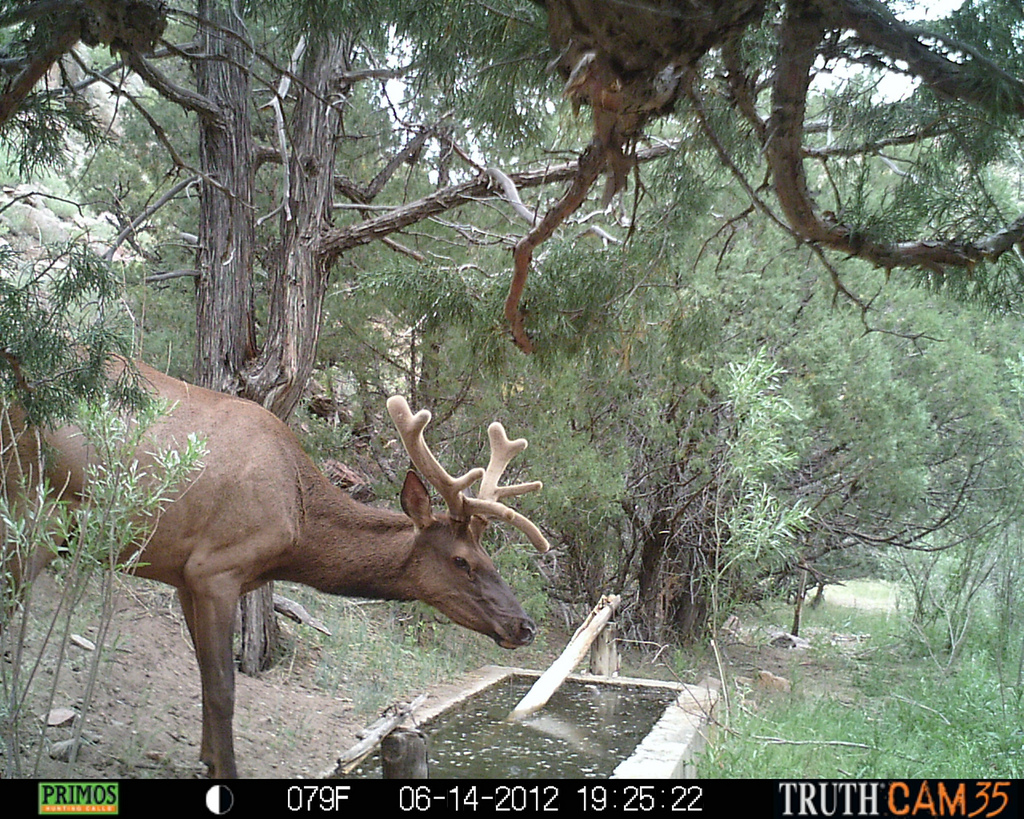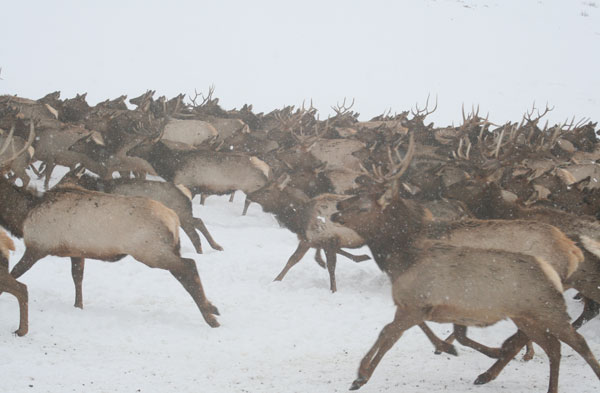Facts About Elk

Elk are members of the Cervidae family, which includes caribou, deer and moose. Like their relatives, elk have massive antlers and long legs with cloven hooves.
Size
Elk tend to be broader than deer, but not as massive as moose. They are typically, 4 to 5 feet (1.2 to 1.5 meters) from hoof to shoulder and weigh 325 to 1,100 lbs. (147 to 499 kilograms), according to National Geographic. An elk’s antlers make it much taller. A male elk's antlers can grow up to 4 feet (1.2 m) above its head, making it around 9 feet (2.7 m) tall in all. Females do not have antlers.
Habitat
Elks are found all over the world. Large wild populations are mostly found in North America, in the western United States from Canada through the Eastern Rockies to New Mexico and in the northern lower peninsula of Michigan, according to the University of Michigan's Animal Diversity Web (ADW). They prefer woodlands, but they can also be found in clear cuts, open mountains, coniferous swamps, aspen-hardwood forests and coniferous-hardwood forests. They tend to stay clear of dense forests.
Habits
Elk are social animals and live in groups called herds. Herds are often quite large, with 200 or more members, according to the Smithsonian. Some herds have over 400 members. The herd is often segregated by gender, with males staying in one group and females in another. Though segregated, herds are matriarchal, which means it is run by a single female.
Harems of elk are common during mating season. A dominant male will have a herd of around six females and their yearlings. The male will defend his territory around the females until mating season is over.
Elk are most active during mornings and evenings. During the summer, elk will often migrate to higher, cooler, elevations and migrate to lower elevations in the winter.
Diet
Elk are herbivores, which means they only eat vegetation. Their diet changes depending on the year, eating grasses in the summer and woody growth in the winter months, according to the ADW. They prefer dandelions, violets, hawkweed, aster, clover and mushrooms as their favorite treats.
Get the world’s most fascinating discoveries delivered straight to your inbox.
Offspring
Males are called bulls and females are called cows. A cow usually gives birth to one baby at a time after a six-month gestation period. Elk babies are called calves and weigh around 31 to 35 lbs. (14 to 16 kg) when they are born.
After just 20 minutes, a calf can stand on its own. After 16 days the calf will join the herd and complete weaning by 60 days of age, according to the ADW. Elk are ready to mate around 16 months of age. They tend to live around eight to 12 years, though they sometimes live to more than 20 years.
Classification/taxonomy
Here is the taxonomy of elk according to the Integrated Taxonomic Information System (ITIS):
Kingdom: Animalia Subkingdom: Bilateria Infrakingdom: Deuterostomia Phylum: Chordata Subphylum: Vertebrata Infraphylum: Gnathostomata Superclass: Tetrapoda Class: Mammalia Subclass: Theria Infraclass: Eutheria Order: Artiodactyla Family: Cervidae Subfamily: Cervinae Genus: Cervus Species: Cervus elaphus Subspecies:
- Cervus elaphus alashanicus
- Cervus elaphus atlanticus
- Cervus elaphus barbarous (Barbary deer)
- Cervus elaphus brauneri
- Cervus elaphus Canadensis
- Cervus elaphus corsicanus (Corsican red deer)
- Cervus elaphus elaphus (Wapiti)
- Cervus elaphus hanglu (Kashmir stag)
- Cervus elaphus hispanicus
- Cervus elaphus kansuensis
- Cervus elaphus macneilli (McNeill's deer)
- Cervus elaphus maral
- Cervus elaphus nannodes
- Cervus elaphus pannoniensis
- Cervus elaphus songaricus
- Cervus elaphus wallichii (Shou)
- Cervus elaphus xanthopygus
- Cervus elaphus yarkandensis (Yarkland deer)
Conservation status
Elks are not endangered, according to the International Union for Conservation of Nature's (IUCN) Red List, because the population is increasing, overall, and it has a wide distribution. There are more than 750,000 elk today in the United States and Canada, according to the Smithsonian.
Other facts
Elk are also called wapiti. This is a Native American word meaning "light-colored deer," according to National Geographic. They are also called red deer.
Bulls grow new antlers every year. New antlers are covered with a soft coating called velvet. When the males fight for mates they rub off all of their velvet by bashing their antlers together during fights of dominance.
Elk antlers have six tines, or branches, total.
Additional resources




